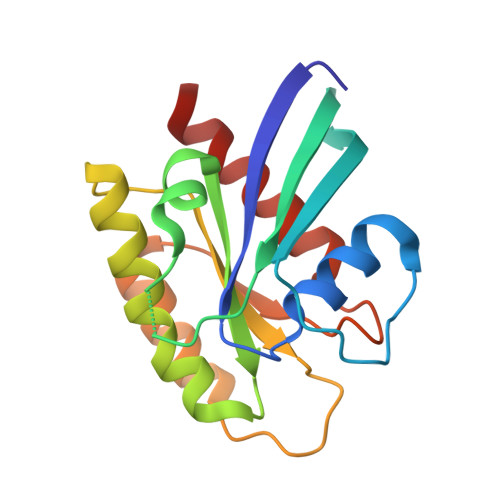Atypical KRASG12RMutant Is Impaired in PI3K Signaling and Macropinocytosis in Pancreatic Cancer.
Hobbs, G.A., Baker, N.M., Miermont, A.M., Thurman, R.D., Pierobon, M., Tran, T.H., Anderson, A.O., Waters, A.M., Diehl, J.N., Papke, B., Hodge, R.G., Klomp, J.E., Goodwin, C.M., DeLiberty, J.M., Wang, J., Ng, R.W.S., Gautam, P., Bryant, K.L., Esposito, D., Campbell, S.L., Petricoin 3rd, E.F., Simanshu, D.K., Aguirre, A.J., Wolpin, B.M., Wennerberg, K., Rudloff, U., Cox, A.D., Der, C.J.(2020) Cancer Discov 10: 104-123
- PubMed: 31649109
- DOI: https://doi.org/10.1158/2159-8290.CD-19-1006
- Primary Citation of Related Structures:
6CU6 - PubMed Abstract:
Allele-specific signaling by different KRAS alleles remains poorly understood. The KRAS G12R mutation displays uneven prevalence among cancers that harbor the highest occurrence of KRAS mutations: It is rare (∼1%) in lung and colorectal cancers, yet relatively common (∼20%) in pancreatic ductal adenocarcinoma (PDAC), suggesting context-specific properties. We evaluated whether KRAS G12R is functionally distinct from the more common KRAS G12D - or KRAS G12V -mutant proteins (KRAS G12D/V ). We found that KRAS G12D/V but not KRAS G12R drives macropinocytosis and that MYC is essential for macropinocytosis in KRAS G12D/V - but not KRAS G12R -mutant PDAC. Surprisingly, we found that KRAS G12R is defective for interaction with a key effector, p110α PI3K (PI3Kα), due to structural perturbations in switch II. Instead, upregulated KRAS-independent PI3Kγ activity was able to support macropinocytosis in KRAS G12R -mutant PDAC. Finally, we determined that KRAS G12R -mutant PDAC displayed a distinct drug sensitivity profile compared with KRAS G12D -mutant PDAC but is still responsive to the combined inhibition of ERK and autophagy. SIGNIFICANCE: We determined that KRAS G12R is impaired in activating a key effector, p110α PI3K. As such, KRAS G12R is impaired in driving macropinocytosis. However, overexpression of PI3Kγ in PDAC compensates for this deficiency, providing one basis for the prevalence of this otherwise rare KRAS mutant in pancreatic cancer but not other cancers. See related commentary by Falcomatà et al., p. 23 . This article is highlighted in the In This Issue feature, p. 1 .
Organizational Affiliation:
Department of Pharmacology, University of North Carolina at Chapel Hill, Chapel Hill, North Carolina.

















